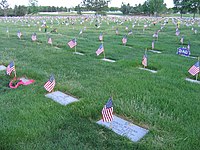
Back United States National Cemetery German Cementerio nacional (Estados Unidos) Spanish Cimetière national des États-Unis French בתי הקברות הלאומיים של ארצות הברית HE Cimiteri nazionali degli Stati Uniti d'America Italian アメリカ合衆国国立墓地 Japanese Система національних кладовищ США Ukrainian











The United States National Cemetery System is a system of 164 military cemeteries in the United States and its territories. The authority to create military burial places came during the American Civil War, in an act passed by the U.S. Congress on July 17, 1862.[1] By the end of 1862, 12 national cemeteries had been established.[2] Two of the nation's most iconic military cemeteries, Arlington National Cemetery which is under the jurisdiction of the Department of the Army, and Gettysburg National Cemetery, under the jurisdiction of the National Park Service, were established in 1864 and 1863, respectively.
- ^ "A Century of Lawmaking for a New Nation: U.S. Congressional Documents and Debates, 1774–1875". memory.loc.gov. Retrieved 2020-12-13.
- ^ Administration, National Cemetery. "Dates of Establishment: National Cemeteries & NCA Burial Sites (1 of 6) - National Cemetery Administration". www.cem.va.gov. Retrieved 2022-09-25.